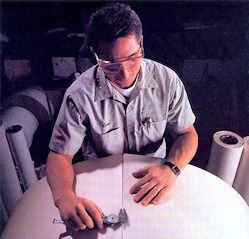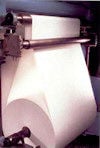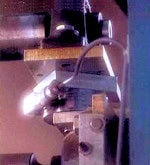Troubleshooting roll bouncing addresses the four probable causes
Sep 4, 2018
Vibration is a natural but acceptable by-product of the papermaking process that winder operators contend with each set they run. However, roll vibration becomes unacceptable when it intensifies enough to actually bounce the rolls, and, in some cases, cause them to be thrown from the winding station. This vibration phenomenon - roll bouncing - was once more common with vibrating grades such as vellum, sackkraft and fine paper. But it can also plague papermakers of non-vibrating grades such as newsprint due to higher winding speeds and shaftless winding.

A contemporary problem
The phenomenon of roll bouncing can occur on any two-drum winder. In the past, shafted winders were able to keep the rolls together and provide stability. However, with the introduction of shaftless winding, roll bouncing became a problem particularly on grades that weren't known to vibrate.
The problem occurs when one roll or a whole set of rolls become unstable in the winder station at high speeds. The rolls bounce around inside the confines of the two-drum winding station. If not adequately confined with safety gates, the rolls turning at surface speeds of ~5000 to 8000 fpm / ~1500 to 2500 mpm are sometimes thrown free of the winder.
A thrown set can damage rider roll bearings, core chucks and misalignment of the winding station resulting in costly downtime and repairs.
Roll vibration can also cause offsets. During severe rocking, rolls lose contact with one or the other drums and lose traction. The web moves side to side, creating an offset. These offsets can be severe enough to interweave adjacent rolls in the set.
Hidden causes
Roll bouncing is a complicated problem, generated typically by more than one cause. The most common causes center around problems in four general areas: mechanical hardware, controls, roll structure and paper properties. A thorough troubleshooting schedule is the best plan of attack against roll bouncing.
Troubleshooting
First, inspect the winder. Pay special attention to the alignment, wear of all sliding parts on the rider roll (bent shafts, bad bearings, obvious vibrating rotating parts and loose parts or assemblies) and core chucks, chain and sprockets.
Check for malfunctioning unwind tension, nipload and torque controls. It's important the torque does not cross over at or near the vibrating range. Also check the drive for excessive deceleration and drum brakes for timing and operation.

Also, there should be no abrupt changes in wound-in tension that could cause localized starring. Wound-in tension at the core should be 10 to 20 percent higher than throughout the roll. Inside the roll it should not drop significantly or starring could occur. But in general, a lower wound-in tension level will soften the roll, which, in turn, may help reduce vibration.

Two other corrective measures are 1) employ a high-speed video recorder to identify the cause (the problem could be a wad of paper under an edge of a roll after a web break), or 2) perform vibration analysis, which can point to a degraded structural member on a winder or to a degraded or weak foundation.
It's wise to remember that any one of the four trouble areas listed can exist for a long time and not cause problems. Some sets vibrate more than others, but the rolls do not necessarily come out of the winder each time it vibrates. If certain grades result in excessive vibration at a particular speed, the control system may be modified to ramp through that speed range into a safer operating speed if needed. An OEM winding expert can assist in such a control modification.
For assistance solving roll bouncing problems, contact your Valmet representative.